This is a TRUE & SUCCESSFUL story from Dale Gillespie, one of our customers.
“Below you will see presented an interesting recovery story from one of our great customers, Mr. Dale Gillespie. Happily, he chose to share with us his experience regarding a Google Penguin Recovery and a successful implementation of a 301 redirect strategy mixed with 404 on pages affected by unnatural links. It’s a great story about perseverance, patience and thinking ahead!”
I’d like to share with you my experience regarding a Google penalty that we’ve received and tell you how we managed to get rid of it and be back on the track again. Was a pain of a job to be honest! But it was made drastically easier, yet still laborious, as a result of perseverance and the use of cognitiveSEO.
1. Multiple Google Penguin Penalties
We were aware of the fact that we had some SEO problems with our existing domains but in the spring of 2013 things became more clear as all of our domains were hit with algorithmic penalties.
As a multimillion turnover and long established car dealer group, we were simply badly equipped for the internet revolution and had taken bad advice. We ended up with all of our sites having directory links and potentially bad links in their profile.
The sites that we’re talking about are:
- Jennings-ford.co.uk
- Jenningskia.co.uk
- Jennings-mazda.co.uk
- Jennings-Seat.co.uk
- Jenningsseat.co.uk
Below are the screenshots taken from analytics, where the drops can be easily spotted.
Smaller sites were worst affected by the Google Penguin Update from May 2013 and other Penguin updates had caused minor drops in traffic. The stronger more established sites weathered the storm but the drop’s were definitely affecting business.

Google Analytics Screenshot – Jennings-mazda.co.uk Ranking Drop

Google Analytics Screenshot – Jennings-Seat.co.uk Ranking Drop
2.The Rebranding Decision
With all our domains being penalized by Google Penguin, something needed to be done in order to recover our ranking, so we started working on some plans of action. A marketing strategy was agreed to rebrand as “Jennings Motor Group” and move all our penalized sites under one new domain, named www.jenningsmotorgroup.co.uk
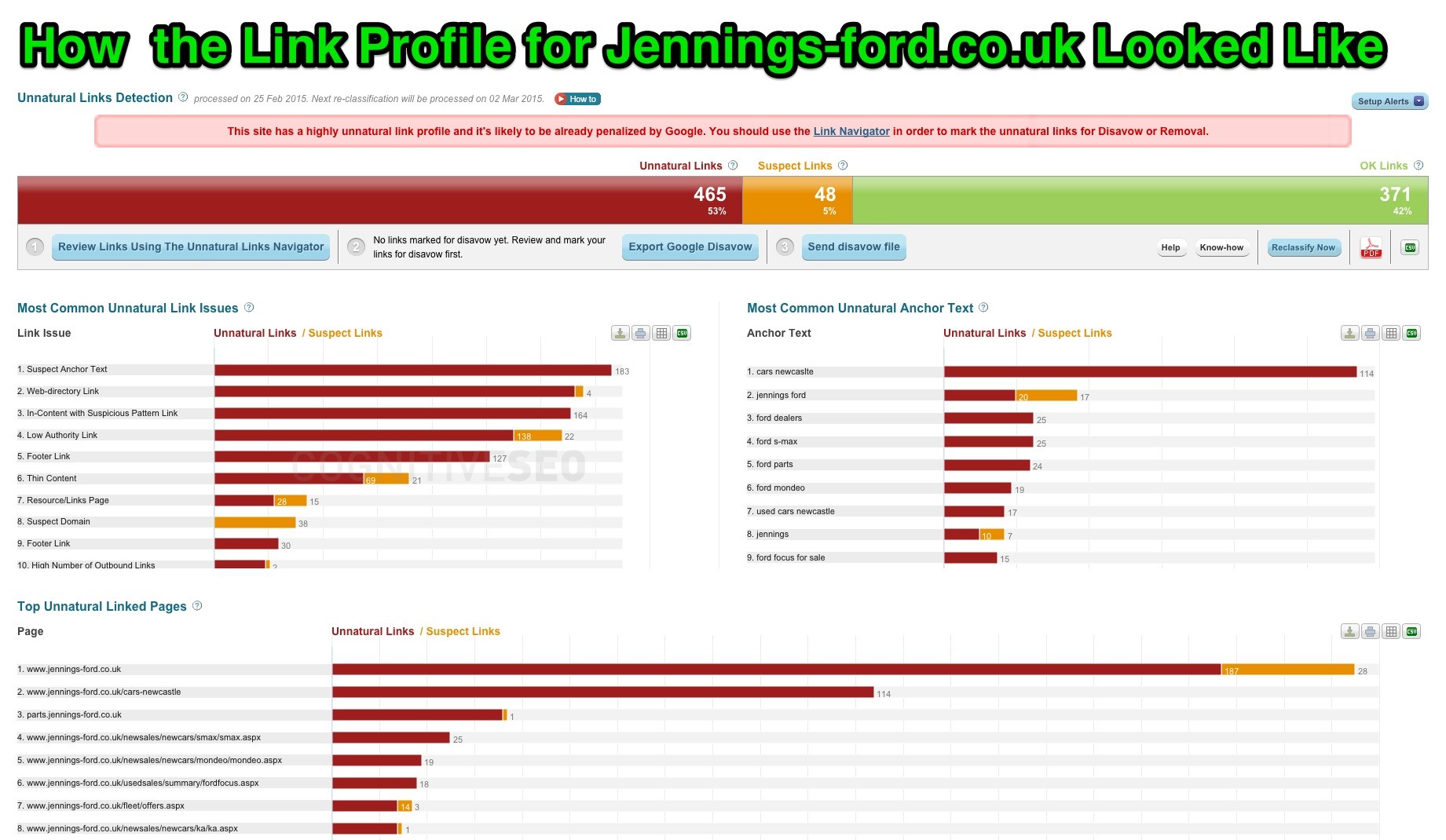
The main concern was doing 301 redirect for all sites to a new domain in the context where we were lightly highlighted by the fact that the penalties would then affect all traffic and search rankings.
Also, our domains had real world value with over 14.000 cars on the road for all the brands that we commercialize. They had solid natural search that could not be abandoned, backed up by the domain names, press radio and other re-enforcement. Therefore, among our worries was how do we make sure that any branding change won’t affect our hard-earned SEO value.
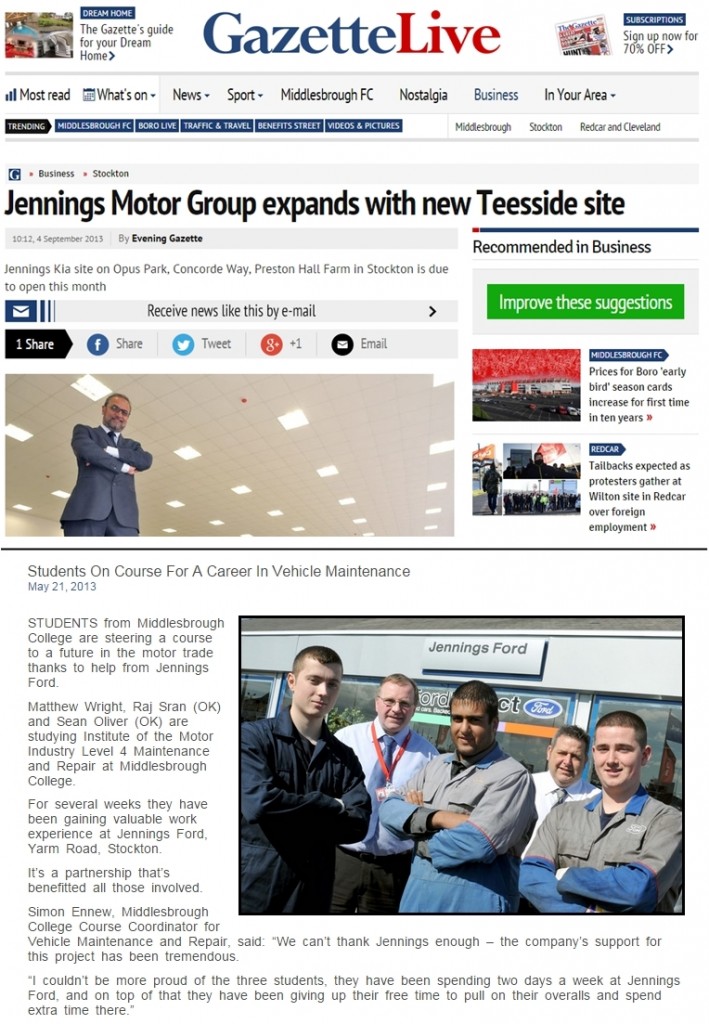
We wanted to tell both users and search engines that our original pages were no longer relevant and that the most relevant and up to date information can be found on a brand new page but also transfer our old domains’ search engine rankings to the new web address.
Car buying requires about 10 website visits before a decision and even after a decision is made, people keep coming back to look at the car before they get it physically. So, maintaining our brand’s authority and awareness was crucial for us.
3. The Implementation of the 301 Redirects
After analyzing the situation, the agreed process was to implement a 301 redirect.
The process was implemented around the 8th of May 2014 and the 301 was done on a page to page basis, for each website individually. We also did 404 to some pages. We had to do further tidy up after this impacted traffic. So, long story short, we combined multiple domains into one single motor group domain so we had to tidy up the backlinks from these sites individually then 301 into the main site.
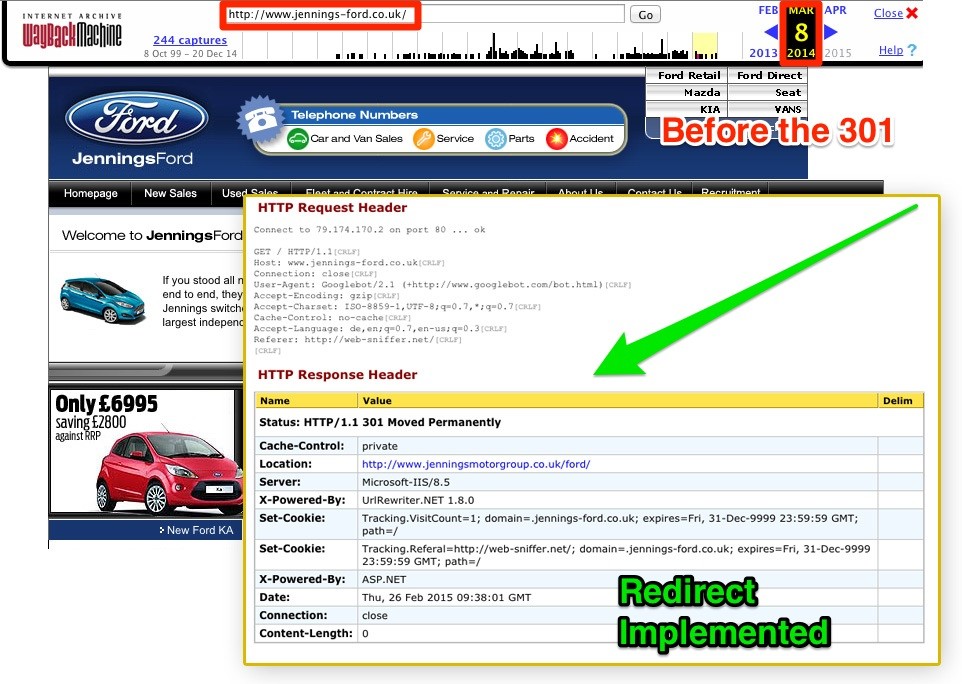
Therefore, we started to try and take out all the other activities that creates solid organic traffic from real world radio, TV, press etc. It seldom drops off a cliff as we would ramp up ads which in turn generate increased organic traffic. We now needed to establish Jenningsmotorgroup.co.uk as a standalone site to do some natural link building and some content marketing for it. We retained the legacy of the other redirected domains so we also needed to do some cleaning in the link yard. We’ve started cleaning the new profile and started building on the value of JMG with high quality content and unique PR activity.
4.The Immediate Penguin Recovery Results
Happily, JMG was established quickly. The website evolved with rapidly improving functionality and quality content. Our bounce rate were reduced and our conversion rates improved consistently.
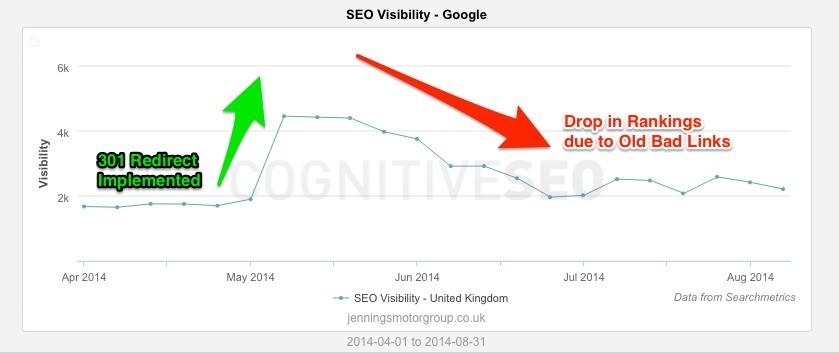
The first 301’s occurred in August 2014 producing a burst in visibility but, as expected, a rapid decline followed, resulting from the combined effect of all the bad links. The Google Penguin recovery was not done yet!
6.The Google Disavow “Dilemma” and the 404 Recovery Technique
Although sustained link building altogether with quality content and correct 301 redirect was done, there were still bad links in our profile, therefore we considered the possibility of submitting a disavow.
On the other side, we thought that every site has some spammy link ratio and maybe it was more important to get our profile as clean as we possibly could. Using cognitiveSEO to identify the bad links, contacting the linking sites and get them taken down and creating good content strategy should do just fine for our profile. We had created the mess so we had to clean it. Disavow was not a route we wished to take but more of a last resort.
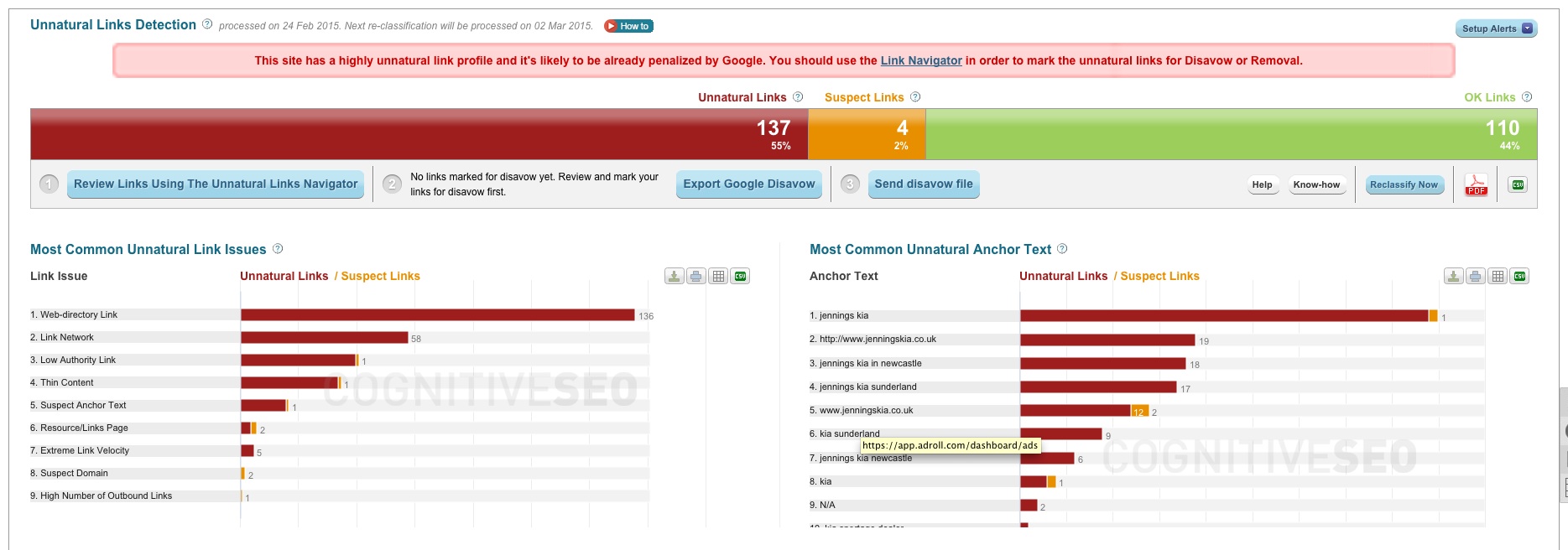
Until now, we have not done a disavow but we have clear in mind that it is an option, although we avoid it by killing off some of the internal pages with 404 rather than 301.
7. A Bright Future Ahead of Us!
If you look at the SEO Visibility over a longer period from, let’s say August last year until today, you will see the huge improvements we’ve made. The big backlinks tidy up that was done using cognitiveSEO with constant monitoring got us here. This year has kicked off with some good sold traffic improvements and we are enjoying solid traffic levels.
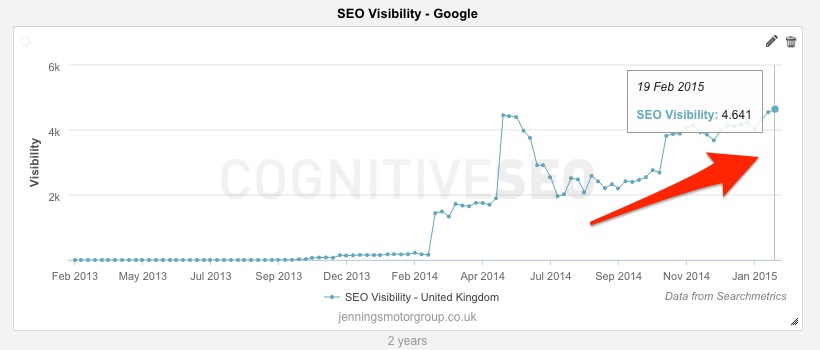
Monitoring is a never ending job. Yet, after all this efforts, we can now proudly look at our link history chart and see a promising evolution of our OK links. We do not have unnatural links in our profile no more and the suspect links evolution trend is descending. As I said at the beginning of this post, it was a pain of a job but we managed to get things right after all with a lot of hard work and using the right tools.

Disclosure
This is not a paid post and cognitiveSEO didn’t make any kind of agreement with the author. This is the successful Penguin recovery story of Dale Gillespie, written and documented by himself.
About the author

Dale Gillespie
Digital Marketing Manager
Jennings Motor Group
20 years experience in the motor trade in systems, sales, marketing and analysis roles. Responsible for heading up the Internet car sales team along with online automotive marketing and website development for JenningsMotorGroup.co.uk. Recently refreshed his skills with a Post Grad in Digital Marketing in 2012/13.

 Site Explorer
Site Explorer Keyword tool
Keyword tool Google Algorithm Changes
Google Algorithm Changes

Thanks for writing this article. I’m always interested in hearing stories of recovery. Please know that the comments that I am about to leave are not criticism, but just a few of my thoughts. I know that when a case study like this gets published, I’m going to get emails from clients asking if they should make similar changes. As such, I can direct my clients to read my comment here.
I think that it is possible that this actually wasn’t a Penguin problem. Or, its possible that it was a little bit of Penguin and mostly something else.
Any Penguin hit site that I have seen has had a drop in rankings that occur on a date of a Penguin refresh or update. In May of 2013 there was a Penguin update on May 22. But, it looks like your traffic started to drop before that. We can possibly make a case for a mild Penguin hit on May 22, but my guess is that this is not the main cause of your problems.
I think you did good work in combining your sites into one. Google much prefers that you concentrate on one main domain rather than several smaller ones. The authority in this one domain probably helped significantly. It looks like you cleaned up other on site quality issues as well, so this would help. It may have improved you in the eyes of Panda (not Penguin), or it may just have improved the signals overall.
A backlink cleanup is never a bad idea. The idea to 404 pages with unnatural links is a good one. That’s a surefire way to make sure you’ve gotten all of the unnatural links pointing to those pages. As you found out, 301s can be dangerous if you’re potentially dealing with unnatural links because you’re passing the unnatural link signals to the new site along with the 301.
So let’s look at your recoveries. The first one you posted happened in May of 2014. There was no Penguin update at this time but there was a significant Panda update on May 20, 2014. But then again, this could have just been because of the boost you got by combining all of your domains into one. The second recovery that you noted (and nice one by the way!) was in February of 2014. Again, there was no Penguin update at this time. We believe that Panda refreshed around February 11. There was also a page layout algo change on February 6. But it doesn’t necessarily have to be because of a major algo change. It may be that your new higher quality signals were being noticed by Google.
Does a Penguin recovery need to happen on the date of a Penguin refresh or update? John Mueller from Google has confirmed this. So many webmasters were waiting for all of 2014 for Penguin to happen to see recovery.
There are also other algorithms that use links in their calculations. They’re not as well discussed as Penguin. I think that it’s possible that the unnatural links in your profile could have been holding you back somewhat with these algorithms (amongst other things) which is why you saw an improvement after disavowing bad links even though it wasn’t a Penguin date.
Regardless, you have been working hard to improve your site overall and that’s always a good thing. Thanks again for posting.
Hi Marie,
Great response thanks! Totally agree with your comments, I really struggled with correlating the drop vs the reality of the google updates timing’s.
However a few more pieces of information:
The 301 was not all done in one lump I did it over an extended period, I didnt keep exacting records so I’ll apologise in advance for that, article would be alot bigger if I had to list out the exact dates for each 301 as the site is 100k pages.
As the new site was not fully functional in that it was not exactly how we wanted from brand perspective but still worked we only 301’ed sections of the site at a time as we were happy with them rather than complete 301 so bad sections were being included and then changed to 404 and taken out, they were done initially with the bulk of pages with deep links to them being 301 toward the end of April.
I additionally had to be mindful of the position of the new Jennings Motor Group site in local search for example fridge keywords that are low volume but high value such as “used Ford Focus Middlesbrough” are surprisingly hard to rank for because competitors like autotrader dominate the market.
SEO is not exact especially when I had so many eggs to juggle.
I agree that I was also unable to correlate the drops with exact matches to google updates that I would have expected to cause the drops, however I personally think its a knock on effect of bad links to the sites linking to us that essentially is a slow burn along with competitors having better “natural” profiles displacing us in search.
The jennings-ford site has a clearer dip on May the 16th that correlates with a google update relating to loans we do offer finance maybe something somewhere in that!
Screen shot of drop = http://www.jenningsmotorgroup.co.uk/getimage.ashx?img=L20150226140303.png&type=Blog
In regards to 2015 steady improvements I think that the volume of good links that we were increasingly disproportionate to the bad effectively making the bad links no longer count.
Thanks for the reply
Dale
An interesting recovery but why was it decided to 404 (not found) the pages that had low quality links? Surely a 410 (page gone) would be far more appropriate in this situation, and more efficient because I suspect you will have a large number of 404 notifications in webmaster tools. Granted 404’s are not regarded as a problem by Google at least at the moment – but as we all know that could well change from one day to the next.
Had the offending pages been 410’d and a site site search been placed on the page to assist the user in finding the content they want would be far better at retaining any traffic that had managed to get to the pages.
probably those pages did not have any important traffic on them. I agree that a 404 with a way to direct the users to a valid page should be the way. Like
“Were you looking for this page”
The 404 pages were generating good traffic, however after the penalties they no longer ranked so traffic was completely cut off they were dead.
I take your point about the 410 and did consider it, but I was nervous that google may pass rank from a 410 in the future to the rest of the site or home page (no evidence of this just my gut). I explicitly did not want to pass anything from those pages and they are still essentially held with the old domain in this case not 404’s on the new Jennings Motor Group website.
Thanks
Dale
tks for clarifying this Dale. interesting the 404 vs 410 story.
The point on using 410 over a 404 is to avoid the situation you feared 🙂 In essence, (and I’m sure most of us know this anyway) from a logical point of view is that a 404 only tells a spider the page cannot be found, as a result the next time the spider visits and finds the page (usually because something either internally or externally links to it) it will show in GWT – even if you have checked it with “mark as fixed”.
By returning a 410 – even if you are serving in a custom 404 page as content on the page – when the spider finds the page you are explicitly informing it that the page is not there, you know it’s not there, it’s not an error, and don’t come looking for it again – regardless of what links to it.
In cases where a large amount of pages need to be removed in a clean up (in my case around 120K on a real estate portal) it is a practical way of clearly instructing spiders of what’s been removed immediately and conserves crawler equity for use on the rest of the site – which, when working on a very large site becomes very valuable because you want the spiders to re-index your site as rapidly and efficiently as possible.
It is a very good point Pete, either option was likely fine, but just to show my logic in making the choice:-
Doing a 404 means it will still be associated with the OLD URL in the old URL’s webmaster tools (I didn’t do a 301 to the new site then 404 on the new url). Therefore I was 100% confident that a 404 would keep any negative equity as it were under the old site and the new domain protected.
Although 410 is potentially the exact same outcome and undoubtedly the correct way to do it, especially so if SEO was not a consideration, my fear was that google may pass any link juice (negative/positive) to the home page as a result of doing it correctly which would then 301 over the negative juice to our home page. Its well documented that they don’t do this for a 404 but 410 is not really clarified like that.
I didn’t analyse the death out of it to be honest just made a decision and got on with it.
Can always still change it if something changes in the future with serps.
But if it aint broke!
Hello there.
Please excuse me first if my english is sometime approximative, i don’t practice that much.
@pete: what you say about the fact that a 410 instructs the crawlers not to come back is theorically true, but we all know that the googlebot do crawl nofollowed links, despite the theorical meaning of the nofollow attribute. The googlebot verifies even simple text citations of urls ! The bot is too angry for possible content that i don’t think it will drop it just because of a 410 seen some times.
I think that even if crawl rate gets lower as the time passes, the bot will always come and crawl the url as long as there is one citation of it somewhere, wether the page is 404d or 410d.
@dale: if you want your visitor to be able to get to a new url equivalent to the one that you 4XXd, why don’t you put a simple html redirect to the new url ? We know that it won’t pass anything, and your real visitors will be transparently redirected to your new page without even knowing it has been moved.
If you think it can be a dirty signal sent to google to use that kind of sneaky redirection, quasi cloaking, and if you really want to show a 4XX page and let the visitor choose to click somewhere to jump to the new page, you can use instead a js “onclick” redirect on a button or an underlined pseudolink, and calculate “on the fly” the redirect url, so that google will never count it as a link, even if its policy about 4xx pages changes to transmission of equity (or penalty) through links.
iMHO
@mathieu
Lost in translation possibly sorry but not 100% where your going with that.
There are no visitors to the page’s that were 404’ed (or prior to 404) but there were prior to google updates. That was the specific problem as a result of the bad links, it would have been a mammoth job to get them taken down as the links were on a wordpress themes thus increasing virally and would have required a disavow plus the disavow would need constant maintenance and updating for any new links.
I am not sure where you are going with this or possibly I have misunderstood your point.
Dale, I was just bouncing on your legitimate concern about 410:
“Although 410 is potentially the exact same outcome and undoubtedly the correct way to do it, especially so if SEO was not a consideration, my fear was that google may pass any link juice (negative/positive) to the home page as a result of doing it correctly which would then 301 over the negative juice to our home page. Its well documented that they don’t do this for a 404 but 410 is not really clarified like that.”
My technical suggestion was just a way to use a “theorically more accurate” error 410 instead of a 404, while allowing navigation from those pages and still ensuring that they will keep their shielding role in case there is a change in the way google treats links in a 410 page, that’s all.
If you meant that what you feared is that those 410d pages, even with no links, could possibly flow something to your home or elsewhere, I am sure it would never be any PR, or penalty/bonus associated with PR and semantics, as this is not the way the PR flows.
However, perharps it could flow some kind of distrust to the whole domain: who knows what is trust for google and how it works ?
Finally, I understand what you did as a cure with those spammed urls, and if no real visitor ever gets to them, there is no need to try to keep those visitors on the website, so avoiding any link in those pages is safer as well as using 404 instead of undocumented 410, I fully agree with that.
By the way, about “lost in translation” problem, in my previous post, I said that “The bot is too angry for possible content”, and you should have read of course “The bot is too >hungry< for possible content" instead. Phonetically near, but semantically totally different… 😀
@Mathieu
With you now thanks for the clarification and a great point about hungry MR google!
Thanks
Dale
Like Marie I think the information about recoveries really helps to everyone, so thanks for sharing your experiences Dale.
Before I got down to the comment by Marie my initial gut reaction was that this probably wasn’t a Penguin issue. Although I agree that it might had added to other problems, but the dates just don’t really correlate for Penguin algo refresh/updates.
It’s a bit of a co-incidence, but I was working in the UK car vertical at this time, ironically with a very similar multiple domain setup. Anyway, the point I was going to make is that nearly all the sites across the brand had a wobble in Spring in terms of SEO visibility/rankingsy, and it wasn’t Penguin (they’d already bought the t-shirt with that). Upon closer inspection it turned out to be Google SERPs. I can’t remember the specific details I’m afraid as it was a while ago, but I believe that it was something to do with the favourable promotion of other types of content in universal, Google Venice and new brand ranking preference.
I don’t have access to Analytics anymore unfortunately, but here’s an example of one of their domains visibility in SEMrush. The domains in the portfolio were all quite similar, but the ‘wobble’ in Spring 2013 is quite visible.
https://salt.mangoapps.com/sf/NDEyNTlfMTE1NzgxNA
I just wanted to share my personal experience of this sector at the time.
On a side note I personally like to use a 410 response ‘Gone’ for pages I want to highlight as removed for a specific reason such as old shady landing pages, but there is no evidence that this would offer any better antispam signal than a 404.
The fact that you did so much domain/content consolidation might have made Panda happier as Marie explains. From my experience Panda often get over looked as the guilty party.
In summary good call with the domain consolidation, and hope it keeps going well Dale.
Great Feedback thanks.
I have multiple contacts who kindly shared stats with me at the time, I cant disclose the company for obvious reasons but I still have access to their analytics quick screenshot =
http://www.jenningsmotorgroup.co.uk/getimage.ashx?img=L20150226142647.png&type=Blog
VS Jennings:
http://www.jenningsmotorgroup.co.uk/getimage.ashx?img=L20150226140303.png&type=Blog
something was clearly different with us against them.
Thanks
Dale
The example stats is for a very similar size car dealer group with a near identical business model to ours.
I’m assuming that’s the car client I think it was back in the day. Thinking back, I do remember a bit of moaning going on about those exact issues and it being one thing after another. 😛
Marie,
I agree that this doesn’t look like a Penguin recovery story.
The spike that took place in May 2014 is mostly a result of consolidating the various microsites into one (after applying the redirects). In such cases it is expected to see a traffic boost given that the new site consists of a lot more content and backlinks. As you said, this doesn’t have much to do with Penguin.
The further visibility drops between May and July could be due to standard link devaluations, which again have nothing to do with Penguin. Google are using various signals to assess backlinks quality – not just the ones that are part of Penguin. This is how it used to be before Penguin was released but many seem to incorrectly think that link devaluations only take place when Penguin updates or refreshes.
Thanks for the feedback.
Yes title of Penguin recovery should probably be
On going Google Penguin and anti spam and bad link update recovery as its more a combination of multiple updates that I believe leads to the drops.
But its hard to put that in a title!
Thanks
Dale
In reference to your comment about the traffic spike yes that was obviously predicted. However its not actually a huge traffic spike as the image suggest more it was a visibility spike. We were loitering page 2 and bottom of page 1 for a large number of terms. During that initial spike we improved briefly across the board slipped but then slumpped again as the combined negative links from all the sites took hold and we dropped the site lower in the search then previous to the individual sites alone it stayed lower for the 2 months shown.
To clarify when the traffic for the new domain was compared to the combined traffic of the individual domains it went up during the spike higher than the combined total of individual sites but then fell LOWER than the combined total prior to the final 301’s and stayed lower.
The chart shows the visibility is low for 2 months after the spike, this was reflected in traffic.
We had initially lost position and traffic in serps by combining sites.
This was not a one day fix but a really long slog to get right.
one of my site is hit by manual penality and my entire site is penalize .
Below is whole message from WBT.
{Pages on this site appear to use aggressive spam techniques such as automatically generated gibberish, cloaking, scraping content from other websites, and/or repeated or egregious violations of Google’s Webmaster Guidelines}
i have done your above mention 301 and 404 technique on my new blog..
is this remove or not need help
it seems this is an on site issue and not a links related penalty. you should check if you have automatic content or use cloaking etc. As the message suggests.
Nothing to say but your story is very inspiring – it’s good to read stories about businesses recovering from Google penalties. My website was once struck by one of the updates, thanks to unscrupulous links made by some guys in Pakistan.
Anyway, I learned a lot from the story, particularly on the technical and job-related aspects. Though the initial drop in traffic wasn’t that significant, it will be in the long run.
Love the articles like these, explaining a concept through a real world situation. But behind this success and many others around the world lie a careful evaluation of the strategy on a regular basis and taking corrective measures.
Google penalty can wreck havoc on an online business. I remember one of my friends had a let go of 80% of his employees after his site received penguin penalty. I am still learning about panda and penguin updates even they were released years ago.
I think my site has redirect issue, so i removed all amazon redirected issues but still see 404 error on that pages. How can i fix this issues?
I think my site has amazon redirect issue, so i removed all amazon redirected link and set as no-follow but still see 404 error on that pages. How can i fix this issues?
I love reading through a post that can make people think. Also, thank you for permitting me to comment!
great post
A backlink cleanup is never a bad idea. The idea to 404 pages with unnatural links is a good one. That’s a surefire way to make sure you’ve gotten all of the unnatural links pointing to those pages. As you found out, 301s can be dangerous if you’re potentially dealing with unnatural links because you’re passing the unnatural link signals to the new site along with the 301.
Does redirecting a penalized link to new link recovers from penalty?